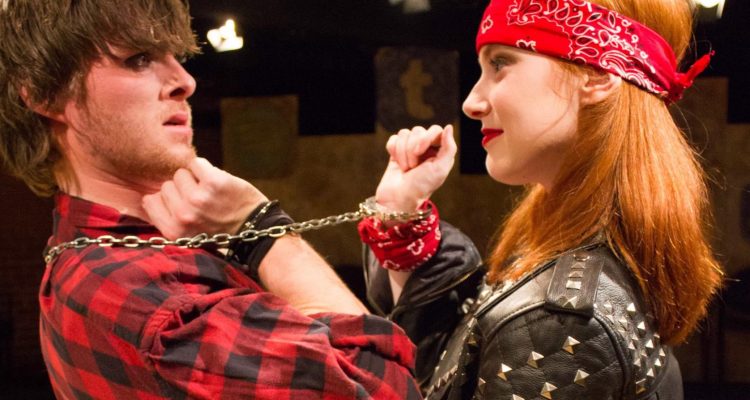I have always found “The Taming of the Shrew” to be one of the most terrifying of Shakespeare’s works. It has no ghosts, no witches, no murders and no convoluted incestuous love affairs. Yet there are scenes that, when done right, send chills through the audience — and this production was done spectacularly right. The play is underlied with allusions of an abusive relationship as Petruchio (Emily Ramsey ‘20) tries to “tame” Katherina (Liam Cahill ‘18), the “shrew.” Katherina is forced to leave her home directly after their wedding, her screams ring from their off stage bedroom on her and Petruchio’s wedding night and she is left starving and begging for food in soiled clothing in the days after. Somehow, Ramsey and Cahill stole the show, portraying the tale in a way worthy of a Shakespearean work where his genius can change an audience’s mind on an entire topic with only a few cleverly played words. The gender-bent “Taming of the Shrew” director, Tom Schwans, took the twisted story and portrayed it as terrifying art. Yet it was these two young actors who convinced their eagerly watching audience to approve of Petruchio and Katherina’s sick “happy ending” at the conclusion of the show, despite the unanimous disgust and confusion over the abusiveness of the relationship.
The entire cast did an amazing job and from the use of modern technology, costumes and music to the inclusion of a party with beer pong at intermission, the entire cast made a point to add something for everyone into the play.
“I thought the play was so good,” enthused Tasha Lynch ’20. “It was funny and I loved how they modernized parts of it while sticking with the original language. They had screens throughout the room which showed what appeared on the actors’ phones and that really added something to the performance.”
Also, knowing that many members of the audience were only in attendance for class requirements, the entire cast worked hard to draw everyone into the play by using audience participation. A move that resulted in the cast orchestrating an elaborate ploy each night which was initiated by an actor placed as a plant in the audience. Each performance, Jordan Mason ‘19 was seemingly randomly selected as one of the many audience members chosen to briefly participate in the play. After being “selected,” Mason was whisked from her seat in a convincing state of confusion before being thrust into the middle of a scene. After 30 seconds of looking lost and desperately looking into the crowd for advice on what she should do, she suddenly stepped forward and the entire audience jumped as she began eloquently reciting each Shakespearean line perfectly, transforming seamlessly from a nervous bystander into an actress in her element. It was a wonderful addition to the performance.
The gender reversal was not quite what everyone expected. While some knew that the opposite genders would be responding to the opposing pronouns for the night, some thought that the play was simply being changed; for example, that Petruchio would be Petruchia and would be a girl. Instead, it was fascinating to see this complete reversal and how easily the cast kept up with the gender-bending charade, continuing it in that whenever they addressed audience members, they would refer to those who appeared to be male as “ma’am” and those who appeared to be female as “sir.” Despite spinning around and addressing numerous people within seconds of each other, the actors never once slipped up, a difficult task as they would interlace these comments in between their lines of original Shakespearean language and in some cases, Italian.
“I thought it was cool,” Carlos Mesquita ‘17 commented on the gender-bent production, “how the cast kept up with the switched genders throughout the performance. Between that and the special effects with the phones, I really enjoyed it and it was my first experience with ‘Taming of the Shrew.’ I’m glad I came to see it.”
Freshman Nick Trewartha was one of the many students who went to see the play for class, but who greatly enjoyed the experience.
“We read this play in class and I was very impressed with the performance and the portrayals. It was very interesting and it also came off very differently than when we read it in class, even though it was the same language. It was a fantastic performance,” Trewartha said.
Trewartha saw a preview performance on Wednesday, April 19 and so was among the first to see “Taming of the Shrew.” He immediately recommended the play to his friends who, he commented, all also enjoyed the performance.
This gender-bent showing of “The Taming of the Shrew” was a must-see show, and anyone who missed it has missed out on a great and fascinating experience. The show gave me, and many others, a new respect for the original play that will not readily fade.


As with all of Shakespeare’s plays there are multiple interpretations of Taming of the Shrew. While feminists views of the work paint it as a tragedy or a grim reminder of the patriarchal society of the time. I implore the readers to remove the politics from the story (or reverse the genders of the characters) and look again.